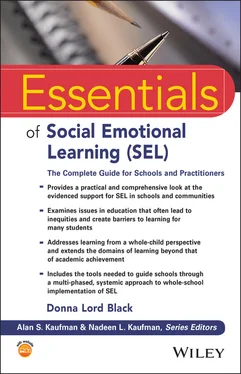Donna Lord Black - Essentials of Social Emotional Learning (SEL)
Здесь есть возможность читать онлайн «Donna Lord Black - Essentials of Social Emotional Learning (SEL)» — ознакомительный отрывок электронной книги совершенно бесплатно, а после прочтения отрывка купить полную версию. В некоторых случаях можно слушать аудио, скачать через торрент в формате fb2 и присутствует краткое содержание. Жанр: unrecognised, на английском языке. Описание произведения, (предисловие) а так же отзывы посетителей доступны на портале библиотеки ЛибКат.
- Название:Essentials of Social Emotional Learning (SEL)
- Автор:
- Жанр:
- Год:неизвестен
- ISBN:нет данных
- Рейтинг книги:5 / 5. Голосов: 1
-
Избранное:Добавить в избранное
- Отзывы:
-
Ваша оценка:
- 100
- 1
- 2
- 3
- 4
- 5
Essentials of Social Emotional Learning (SEL): краткое содержание, описание и аннотация
Предлагаем к чтению аннотацию, описание, краткое содержание или предисловие (зависит от того, что написал сам автор книги «Essentials of Social Emotional Learning (SEL)»). Если вы не нашли необходимую информацию о книге — напишите в комментариях, мы постараемся отыскать её.
Essentials of Social Emotional Learning (SEL): The Complete Guide for Schools and Practitioners
Essentials of Social Emotional Learning (SEL)
Essentials of Emotional Learning (SEL
Essentials of Social Emotional Learning (SEL) — читать онлайн ознакомительный отрывок
Ниже представлен текст книги, разбитый по страницам. Система сохранения места последней прочитанной страницы, позволяет с удобством читать онлайн бесплатно книгу «Essentials of Social Emotional Learning (SEL)», без необходимости каждый раз заново искать на чём Вы остановились. Поставьте закладку, и сможете в любой момент перейти на страницу, на которой закончили чтение.
Интервал:
Закладка:
Once the three‐step process has been completed successfully, the school or district can move forward with developing a detailed, multistage SEL implementation plan that includes goals, strategies, identified needs or resources, timelines, anticipated outcomes, and methods for monitoring and measuring progress, as well as for adjusting, changing, and improving the plan.
Source : An Introduction to Social‐Emotional Wellness in Texas Schools, A Guide for Schools, Agencies, Organizations, Parents, and Communities. Nancy P. Razo, Ph.D., LSSP. Texas Collaborative for Emotional Development in Schools. © 2017, SPEDTex.
APPLICATION OF THE THREE‐STEP PROCESS: A CASE EXAMPLE
The following serves as an illustration of just how critically important it is to establish a common language as the first step in the SEL implementation process. It provides a detailed description of how one group overcame critical communication barriers and was able to develop a better understanding of the challenges and issues schools face in implementing a sustainable approach to SEL.
Case Example: Texas Collaborative for Emotional Development in Schools (TxCEDS)
The following information is based on information obtained from meeting documents, personal knowledge, and observations related to the TxCEDS project that began in 2007 and ended in 2011 (M. Cordeau, personal communication, April 7, 2020) .
Background
In 2007, the Texas Education Agency began a project to address the rising mental health needs of students in Texas’s public schools. The project was led by the Region 4 Education Service Center and was known as the Texas Collaborative for Emotional Development in Schools , or TxCEDS (Texas Education Agency & Region 4 Education Service Center, 2010). A diverse group of key stakeholders representing parents, educators, mental health professionals, graduate training programs, child‐serving agencies, and other organizations in the state was assembled in Austin, Texas. The group was charged with developing a mental health model that could be used as a guide for schools in addressing the escalating mental health needs in schools throughout Texas.
Process
The initial convening of the group focused on establishing the committee’s purpose and identifying project outcomes. After researching, examining, and discussing the issues on school mental health, the committee than set out to prioritize the issues and begin the process of developing a proactive, state intervention model. As discussions evolved, the committee began to realize that the development of a school‐based model was far more complex than originally anticipated. The evolution of this process brought to light a clear recognition that there could be no one solution for the commonly shared problems that schools faced when addressing student mental health. The committee acknowledged that this was largely due to the vast differences between the school communities in Texas, but also was partly due to how committee members perceived and understood the fragmented and complex systems regulating eligibility for mental health services, how those services were funded, availability and access to the services, and the occupational requirements that governed the professionals providing those services.
Each stakeholder involved in the project held a very different perspective on the issues of school mental health, and each member’s understanding of those issues was directly influenced by how she/he perceived the eligibility determination process for services. This included how the need for services was established and how the minimum standard of care was determined and evaluated. Consequently, the varied perspectives on these issues (i.e., lack of a common perspective) resulted in members struggling with how they might arrive at a possible solution to the problem.
During the early phases of the project, a significant amount of time was devoted to increasing the committee’s understanding of school systems and public education laws, including special education laws. Several non‐school stakeholders and parents in the group expressed concern with public school processes for identifying students who might need mental health services. Several of these stakeholders felt schools were consistently denying services to children, despite many of these students being diagnosed with mental health conditions. However, when the school professionals in the group responded to this concern, they explained that schools were obligated to provide educational services, and, although some educationally related services might be considered mental health services, the eligibility criteria for those services were established by education laws, not mental health or healthcare laws. These school professionals described the special education eligibility process (using acronyms commonly used in the special education process) and the educational programs provided through special education. This helped the committee members differentiate and better understand the services provided in public schools from those provided in the private sector or through public health services.
It soon became obvious to everyone that the language used to describe educational services was very different from the language used to describe mental health services. Clearly, this was an area where misperception and misunderstanding seemed to be perpetuating the problems and, ultimately, preventing any possible solutions. The group quickly recognized that the language used among the stakeholders (e.g., school vs. non‐school) was distinctly different, and frequently focused on how children were diagnosed versus how they were categorized, how services were educationally relevant versus clinically relevant, and how credentials held by each professional were regulated differently. Ultimately, these discussions led to the realization that a common language was essential in order for the group to develop a common understanding and perspective on the issues, for without a common perspective, the group would have difficulty arriving at a common vision for developing viable solutions.
Critical Issues Identified
As a result of stakeholder input in the early phases of the project, the committee identified three critical issues that were preventing them from understanding the complex issues surrounding school mental health. After considerable discussion, it became clear that the group was “admiring the problem” and that these issues were creating barriers in their ability to move forward. Thus, the group recognized that if they were to achieve their goal of working cooperatively to develop a mental health model and guidance document for schools, they first had to understand the issues from one another’s perspectives. These three critical issues were:
1 The fragmented and complex mental health system that regulated eligibility for services was creating significant confusion for everyone. How those services were funded only added to the confusion.
2 Throughout the state, availability and access to mental health services were extremely limited, and many of the group’s members weren’t even aware that some of these services existed. This exacerbated the school mental health problem and may have contributed to why so much of the blame was being placed on schools.
3 The regulatory requirements that governed the professionals providing mental health services differed for professionals in the private or public sector compared to those in the educational sector.
Outcomes
The process for arriving at a common understanding and shared perspective on the problem of school mental health required the group to investigate all issues and conduct an in‐depth review of relevant data, including any procedures, policies, or regulations that might have created limitations, constraints, or unintended consequences for any of the sectors (i.e., private, public, or educational). After this thorough review process, all members of the group had an improved understanding of the issues underlying school mental health, as well as those factors driving the increased need for services. The three‐step process that guided the group toward a common vision also enabled them to work toward the goal of developing a school model for mental health support. Ultimately, the group agreed that a proactive approach not only was more effective at preventing social, emotional, and behavioral problems, but also would help reduce some of the stigma surrounding mental illness. So, the group agreed that the model should focus on promoting wellness, as opposed to focusing primarily on mental illness. The project culminated in the development of the Texas School‐Based Social/Emotional Wellness Model , which was based on a multitiered approach to prevention and intervention. A detailed description of the model can be found in Rapid Reference 1.5.
Читать дальшеИнтервал:
Закладка:
Похожие книги на «Essentials of Social Emotional Learning (SEL)»
Представляем Вашему вниманию похожие книги на «Essentials of Social Emotional Learning (SEL)» списком для выбора. Мы отобрали схожую по названию и смыслу литературу в надежде предоставить читателям больше вариантов отыскать новые, интересные, ещё непрочитанные произведения.
Обсуждение, отзывы о книге «Essentials of Social Emotional Learning (SEL)» и просто собственные мнения читателей. Оставьте ваши комментарии, напишите, что Вы думаете о произведении, его смысле или главных героях. Укажите что конкретно понравилось, а что нет, и почему Вы так считаете.












